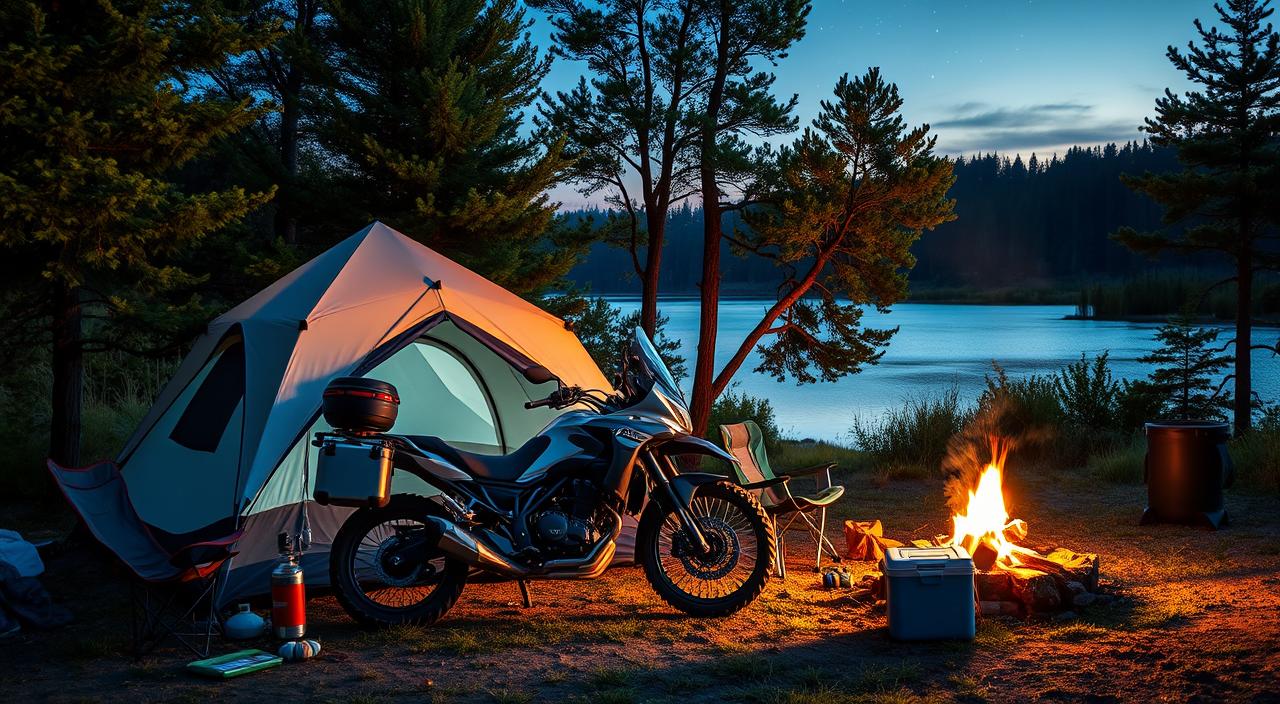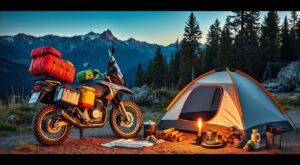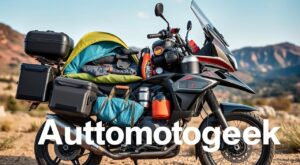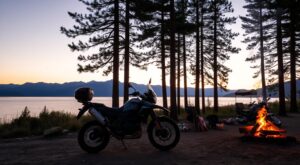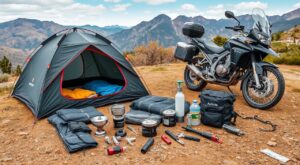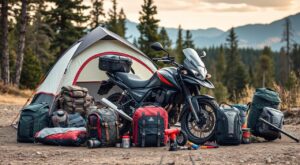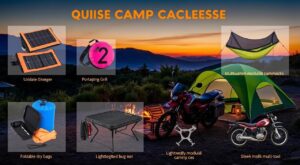Going on a motorcycle camping trip is more than just the excitement of riding. It’s also about enjoying the peace of nature. Over time, I’ve learned that planning ahead makes a big difference. By focusing on the right gear and tips, I’ve made sure each trip is both fun and comfortable.
Combining motorcycle trips with camping brings together adventure and relaxation. It’s perfect for bike lovers. Whether you’re experienced or new to riding, motorcycle camping changes how you see your bike and the outdoors. Let’s explore how to make these trips special.
Key Takeaways
- Invest in moto-specific luggage systems for easier packing and increased comfort.
- Select reliable camping gear brands like MSR, Big Agnes, and Thermarest for quality equipment.
- Choose established campgrounds with amenities for a hassle-free camping experience.
- Plan your route and check for motorcycle-friendly campsites using various apps.
- Maintain a balanced weight distribution on your motorcycle for a smoother ride.
- Prioritize the use of waterproof bags to keep essential contents dry.
- Embrace the joys of rustic camping while adopting tips to ensure safety from pests.
Understanding the Magic of Motorcycle Camping
Motorcycle camping is a mix of adventure and peace. It lets me escape the busy life and enjoy nature. Imagine riding on winding roads with the wind in your hair, then camping under the stars. This type of camping makes my experiences richer as I meet new landscapes and cultures.
When I start a motorcycle camping trip, I can pick between campsites with amenities or remote spots. Campsites with amenities have restrooms and water, perfect for beginners or those wanting comfort. Remote spots offer the thrill of being alone in nature but require knowing how to be self-sufficient.
The heart of motorcycle camping is the adventure it brings. Each trip helps me grow personally, pushing me out of my comfort zone and teaching me new skills. Stories of travelers like Ted Simon, who rode 64,000 miles through 45 countries, inspire me to hit the road with courage and determination.
Choosing the right place for camping is key. Weather, terrain, and my experience level affect how much I enjoy it. For long trips like Theresa Wallach and Florence Blenkiron’s 14,000-mile journey across Africa in the 1930s, knowing your limits and the terrain is crucial.
Motorcycle camping lets me explore new places with every ride. I love moving from one beautiful spot to another, letting nature refresh my spirit. With the right gear, planning, and attitude, each camping trip becomes a memorable experience.
| Motorcycle Camping Essentials | Details |
|---|---|
| Ideal Tent Size | Two- to three-man option |
| Recommended Sleeping Bag Rating | 0°C minimum |
| Drinking Water | 1 liter per person upon arrival |
| Time to Boil Water (JetBoil) | 60 seconds |
| Tent Setup Time | Less than 5 minutes with 8 pegs |
| Recommended Camping Supplies | Three each of paper towels, tin foils, sandwich bags |
Essential Motorcycle Camping Gear
Getting ready for a motorcycle camping trip means having the right gear. It makes sure you’re comfortable and have fun. Two main things are crucial: picking the best motorcycle tent and getting a good sleeping bag.
Choosing the Right Motorcycle Tent
Choosing a tent made for motorcycle camping is key. The Lone Rider ADV tent is a great choice, lasting over two years for $379. It has enough room for you and your bike, keeping your gear handy.
Backpacker tents are also popular for their light weight and fit on smaller bikes well. When picking a tent, think about how easy it is to set up and its design for different landscapes.
Investing in a Comfortable Sleeping Bag
Finding a good motorcycle sleeping bag is just as important. For camping in three seasons, a bag rated for 20 degrees will keep you warm. Look for bags that are compact and easy to pack.
Adding things like air mattresses can make you more comfortable without taking up much space. Using packing cubes or other storage solutions helps keep everything organized. This makes camping more enjoyable.
An experienced rider said that having the right gear makes a big difference in how well you do each day. This shows why investing in good equipment is so important.
Planning Your Motorcycle Camping Trip
Planning my motorcycle camping trip means thinking ahead for a fun experience. Choosing the right campsite and planning a comfy route makes the trip better. With a good motorcycle camping checklist, I’m ready for anything and enjoy every moment.
How to Choose a Campsite
I look at the terrain and environment when picking a campsite. It’s key to skip places with lots of moisture or pests. Before setting up, I check the ground is flat and right for sleeping. Things like water access and being close to trails or pretty views matter too. Here are some tips:
- Check for moisture levels in the ground.
- Avoid areas with thick vegetation that might harbor critters.
- Look for locations that offer shelter from wind.
- Ensure the site allows for clear visibility in case of emergencies.
Planning Your Route for Comfort and Enjoyment
Planning my route makes getting there and the ride better. I pick scenic roads and fun paths over highways. I think about fuel stops and places to rest and see things. A good plan lets me enjoy every bit of the trip. Here’s how to make a good plan:
- Identify key landmarks or attractions along the way.
- Factor in timing for rest stops and meals.
- Consider weather conditions and adjust your schedule accordingly.
- Stay flexible in case of unexpected detours.
Tips for Staying Comfortable While Motorcycle Camping
Motorcycle camping requires a mix of upkeep and smart packing. Before I start my trip, I make sure I know what my bike needs. Regular maintenance checks are key for a smooth ride. And, packing right helps avoid the problems that come from packing too much.
Maintaining Your Bike for a Smooth Ride
To make my trips more comfortable, I focus on bike maintenance. I always check the tire pressure and fluids before leaving. Having properly inflated tires makes the ride stable and fun. A smooth ride is key to a good camping trip, so I always do these checks.
Packing Smart to Avoid Overpacking
One of my top tips is to make a packing list. I include must-have toiletries and gear but don’t overdo it. I make sure the weight is spread out evenly on the bike. This makes riding easier and safer, making my camping time better.

| Pack Item | Weight (lbs) | Importance |
|---|---|---|
| Tent | 4 | Essential shelter for comfort |
| Sleeping Bag | 3 | Critical for warmth |
| Clothing Layers | 2 | Warming and versatile |
| Cooking Gear | 5 | Needed for meal preparation |
| First Aid Kit | 1 | For safety and emergencies |
With the right maintenance and packing, I use these tips to stay comfy while motorcycle camping. Every detail helps make the trip better, letting me enjoy the journey more.
Setting Up Camp Efficiently
Setting up camp right is key to a great night outdoors. I make sure to pick the best spot for my tent and park my motorcycle safely. These tips make the process easier and make me more comfortable.
Finding the Ideal Spot for Your Tent
When I get to a campsite, I look for flat ground without rocks or moisture. A good spot should be easy to get to and well-ventilated. Here are some tips:
- Stay away from falling branches.
- Keep away from water to avoid humidity and wildlife.
- Check the ground for softness for better sleep.
How to Properly Park Your Motorcycle
It’s important to park my motorcycle safely and conveniently. Before settling in, I check it’s in good shape. Here’s how I park:
- Look for a flat spot away from busy areas.
- Use the kickstand and make sure it’s stable.
- Keep valuables safe in my panniers.
- Park facing uphill to avoid rolling.
Following these steps makes camping more comfortable and fun. Testing my gear at home helps avoid problems later. Using special panniers for things like food and cooking gear keeps things organized. This makes my trip efficient and fun.
| Tips | Description |
|---|---|
| Test Gear at Home | Get to know your equipment to avoid issues at the campsite. |
| Panniers Organization | Use bags for specific items for better organization. |
| Conduct Shakedown Run | Try packed gear locally to find any problems before you go. |
| Pack Comfortably | Pick sleeping gear for a good night’s rest. |
| Plan Food Choices | Add fresh foods to your trip for better meals. |
Mastering Camp Cooking Basics
Embracing the culinary side of motorcycle camping can make my trips more enjoyable. Learning simple camp cooking techniques helps make meal prep easier. It makes cooking on the go less stressful.
Simple Cooking Techniques on the Road
Cooking meals while motorcycle camping doesn’t need to be hard. I often choose lightweight and nutritious foods that fit my travel style. Dehydrated foods are great because they’re light and easy to prepare. They let me enjoy filling meals without taking up much space.
For longer trips, I pack non-perishable items like canned goods, granola bars, and jerky. These are not only affordable but also keep me fueled with snacks. Planning meals with shelf-stable foods helps me avoid food spoilage. This way, I stay well-fed without extra trouble.
Essential Cooking Gear for Motorcycle Campers
Having the right gear is key for successful motorcycle camping cooking. The Jetboil Flash stove is my top choice, boiling water in about 100 seconds and weighing over 13 ounces. It’s compact and gives me the quick cooking I need for hot meals and drinks.
I also use lightweight titanium cookware. It’s light but strong. I keep ingredients fresh in airtight containers. Using multi-use tools and compression bags helps me pack smarter, saving space.
With these techniques and gear, I not only feed myself but also make lasting memories by the campfire. Cooking in nature adds a special touch to my motorcycle camping adventures.
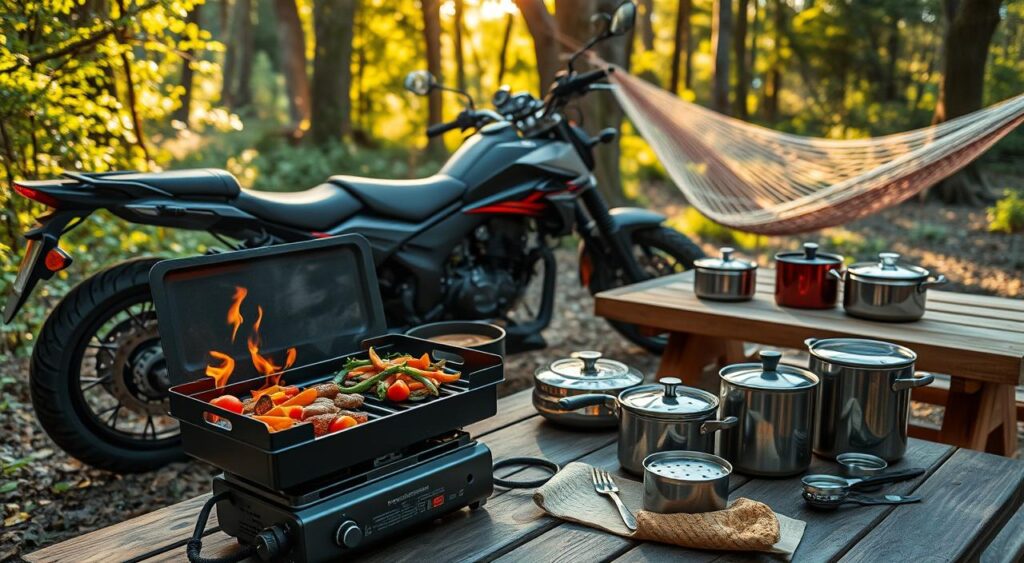
Staying Safe From Pests and Wildlife
When motorcycle camping, keeping safe from pests and wildlife is key for a good time. I’ve learned that managing bugs and storing food right can really help. Let’s look at ways to keep bugs away and some tips for storing food to avoid animals.
Effective Ways to Keep Bugs at Bay
Keeping bugs away is crucial for safe motorcycle camping. I use a few methods to reduce insect problems:
- Use insect repellent sprays with DEET or natural options like citronella.
- Wear light-colored clothes, as dark ones attract more bugs.
- Set up camp away from still water, where insects breed.
- Light a campfire to reduce bug activity.
- Consider using bug nets over sleeping areas for extra protection at night.
Food Storage Tips to Attract Fewer Animals
Proper food storage keeps wildlife away from your campsite. Here are some top tips I’ve found:
- Store food in airtight containers to block strong smells.
- Keep raw and cooked foods separate to avoid contamination.
- Make sure cold foods are kept cool before storing.
- Dispose of waste properly to protect the environment and keep animals away.
- Think about using bear canisters or food bags hung from trees in bear areas.
By using these tips, camping becomes more fun. I can enjoy the adventure without worrying about pests or wildlife. Each night in the wild is peaceful, knowing I’ve taken safety steps.
Comfortable Sleeping Strategies
Getting ready for a motorcycle camping trip means making sure I get a good night’s sleep. A good sleep system is key to feeling fresh after a long day. I choose expedition tents for their strength and a lightweight backpacking tent for solo trips to keep my gear light.
I pick a sleeping bag that fits the weather and a sleeping pad that keeps me warm. These choices are key to a good night’s sleep while camping.
Choosing the Right Sleep System
For comfy camping, I look at the sleeping bag’s temperature rating. It’s important to match it with the weather. I like the MiniTent or MotoTent for their easy setup and space.
I use layering to adjust to changing temperatures. Adding thermal liners or jackets lets me stay cozy. This way, I wake up refreshed for more adventure.
Layering Your Sleeping Gear for All Conditions
Layering my sleeping gear is a skill I’ve honed. I get ready for different temperatures with full-length pads or hammocks. Hammocks are great for their light weight.
I keep extra clothes dry in waterproof bags and bring a headlamp and chargers. These steps help me get a good night’s sleep for the next day’s journey.
